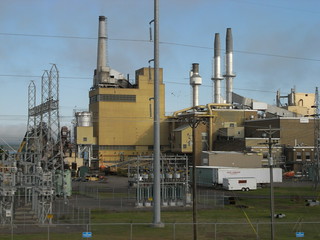 The pumps, conveyors, cranes and turbines that make power generation possible operate with numerous moving parts. Lubricants help keep these critical components moving continuously so power-generation plants can meet ever-increasing electricity demand.
The pumps, conveyors, cranes and turbines that make power generation possible operate with numerous moving parts. Lubricants help keep these critical components moving continuously so power-generation plants can meet ever-increasing electricity demand.
The Energy Information Administration expects total electricity demand in the U.S. to grow 28 percent from 2011 to 2040.
Meanwhile, power plants are under increasing pressure to step up their sustainability efforts. If you’re a power plant manager or operator, you know petroleum-based lubricants and fuels pose environmental risks.
Inevitably, some oils will escape, finding their way into the process, cooling or cleaning water that flows throughout a plant. Hydroelectric plants are particularly vulnerable because the high-pressure process water that drives turbine components also tends to strip away essential lubrication.
This oily, greasy water can flow to outflow collection points of cooling systems and the wastewater treatment facilities as well as drainage sumps or pits deep within the plant. Power plants may use oil/water separation systems to flow concentrated waste oil to a collection area.
Maintaining the separators is essential to ensure continuous removal of the accumulated waste oil layer. Otherwise, waste oil will build up and possibly escape from the vessel or combine with dirt and debris to form a sludge that can enter adjacent pipes, pumps and flow controls.
Oil Skimmers Inc. helps these massive power-generating operations reduce contamination with cost-effective automated oil-skimming technology. Automated oil skimming removes oil with efficiency that meets or exceeds other methods with lower labor and disposal costs. That’s because it captures and concentrates waste oil with little or no free water.
First, let’s look at how other methods work and why they’re not ideal for industrial oil-skimming:
- Absorbent materials can prevent the spread of a small oil leak but are not practical everyday solutions. Plants that use absorbents for larger volumes of waste oil pay recurring costs to restock and dispose of the small pads that can’t cover a wide area.
- Manually operated slotted pipes are not sufficient either. Many separators feature a slotted pipe located near the top of the vessel that has a horizontal opening. Oil is removed by turning the horizontal opening downward until it meets the floating oil layer, which drains through the pipe to a collection receptacle. Slotted pipes work on thick layers of oil but can’t drain off oil without removing a large amount of water as well.
- Vacuum truck removal features vacuum-equipped tank trucks that remove waste oil from collection points at plants. Many plants use vacuum disposal units to pump oil layers directly off of water. This causes a significant intake of water along with the waste oil, resulting in additional costs.
Oil Skimmers’ automated floating tube system is more versatile because it offers:
- A vertical lift: An oil skimmer must be able to reach the oily water where oil removal is needed. Drainage pits or sumps may be located up to 100 feet deep in the structure of a plant, making them difficult to access for inspection set-up, adjustment or maintenance of skimming equipment. Vertical-lift capability can eliminate or greatly reduce all of these problems.
- The ability to manage water level fluctuations: Within a pit or sump, oily water levels can fluctuate widely, making it difficult or impossible to apply and remove absorbent media or to access and operate a slotted pipe. Oil Skimmers’ collector tube floats up and down with the liquid level.
- Ability to cope with varied oil amounts and concentrations: Other types of skimmers work according to slight differences in depth. They may leave a sheen behind because they are adjusted too high to collect a thin sheen or draw in significant amounts of free water because they are adjusted too low. Floating tube skimmers collect oil by attraction, not relative depth, so they’re better at removing a light sheen of oil.
- Ability to cope with debris. Skimmers vary in their ability to remove oil from water where debris is present—a common circumstance in power plant drainage systems. The operation of fixed-position belt skimmers or floating skimmers that have fixed inlets can be disrupted if debris collects around them and limits access to floating oil. The movement of a floating tube skimmer eliminates this potential problem since it continuously snakes around the surface and moves debris out of the way.
The flexibility afforded by automated oil skimmers can cut labor costs associated with managing oily wastes, reduce disposal costs by collecting a higher concentration of oil and improve efficiency by removing oil continually and unattended.
FREE WHITE PAPER: Solving waste oil management and removal problems in power generating plants
Photo by Seth Tisue


